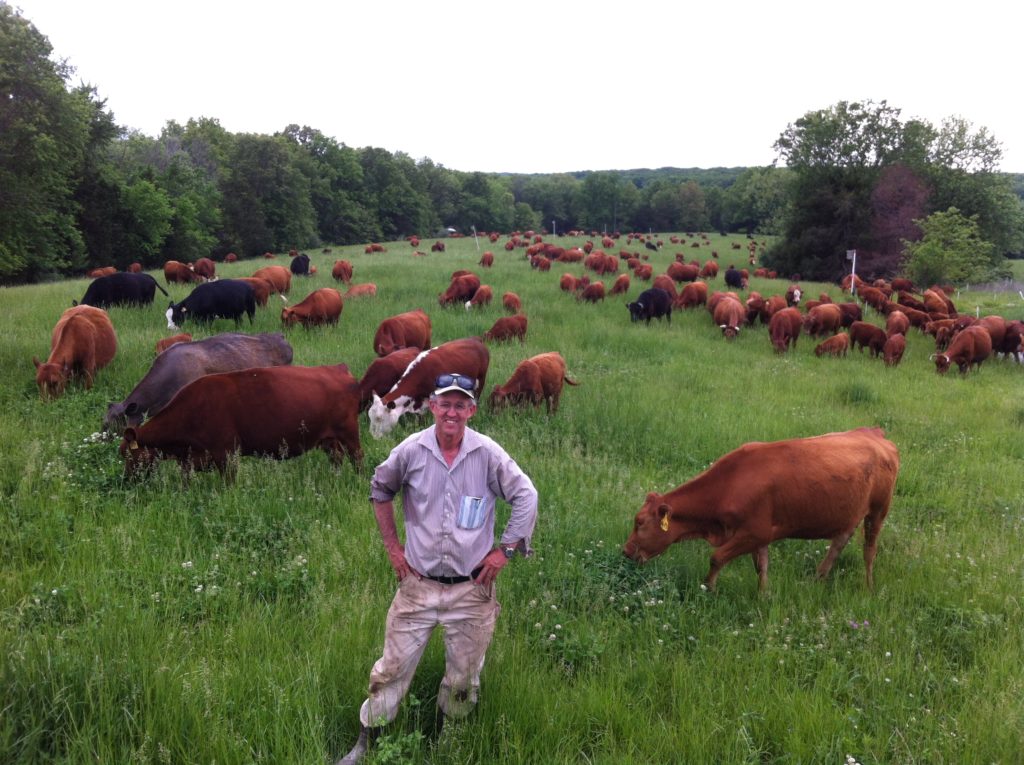 Grazing expert Greg Judy shares his grass-growing and grazing expertise.
Grazing expert Greg Judy shares his grass-growing and grazing expertise.
Frequent moves, never over grazing, and providing shade are all part of the grazing strategy on Greg Judy’s farms in Rucker, Missouri. Judy grazes South Poll cows, cow/calf pairs, bred heifers, bulls and stockers across 16 farms – four owned and 12 leased.
The two-a-day moves Judy makes with his cattle don’t slow down in the autumn months. “That’s because we have been able to grow so much grass,” he explains.
According to Judy, having ample grass in the fall begins in the spring. “When you give your grass a little head start in the spring and you don’t over graze, it sends back more appendages…If you take off say 1/3 of the leaves, you are going to get more coming back. That is what we have done across all of our farms.”
Stockpiling
Stockpiling period typically runs August 1 through the first killing frost. There are two stockpiling methods used by graziers. One is locking cattle down and preventing them from grazing a portion of the pasture. This, Judy says, is not a good strategy for success.
“The problem with that method is when you lock your cattle down on a smaller part of the farm, they over graze that area. You may even have to feed some hay to buy enough time for the rest of your farm to recover and grow stockpile.”
This method could even result in animals dropping weight, adds Judy. “They are used to being moved and all of the sudden you are locking them down. Your cows are losing condition going into winter.”
A better strategy is continually grazing cattle, making sure they never eat the grass down too short. Currently on the fourth rotation on his farms, Judy adds “As we graze around our farms, we are taking just the tips and moving on.”
A farm visitor recently asked Judy why he was moving the cattle when there was so much grass there. He replied, “That’s why I have all this grass. It’s because we moved them.”
The importance of shade
While this might be the time of year for stockpiling, it also includes some of the hottest grazing days. Providing shade for grazing cattle is a top priority for Judy. “We have 350 animals out there. If it’s 90 degrees, I want to make sure they can ALL get in the shade. That’s how important I think shade is.”
“We are in the weight conversion business. If animals are hot and they’re stressed, they are not putting on,” says Judy, using a phrase his father used. “They are not putting weight on.”
Judy’s farm is in an area with rolling hills and trees in every paddock. And while he doesn’t require movable shade himself, he notes for those without trees, “Moveable shade is best, because you’re moving the fertility around your pasture.”
While conducting a workshop in July, Judy observed two Shade Haven mobile shade systems. “It’s a great product, and the fact that you can hook it on to your Kubota and move it is priceless. It’s like planting a tree in your pasture every day that you move your animals. And you’re moving nutrients around. That’s what I like about it.”
No bare soil here
You won’t find bare soil anywhere on Judy’s farms. That’s because he never lets cattle graze it down that far.
“You can’t intercept solar energy with bare soil. We call ourselves light interceptors. We are trying to intercept that sun before it hits that ground onto a blade of grass, or a bush or it might even be a weed – I don’t care as long as something is growing. I detest bare soil.”
The war against bare soil has an added benefit of easing the impact of weather extremes. “I think droughts and these weather extremes are getting more frequent. We are going to have to learn to manage around this,” notes Judy. “The way you manage around droughts is by keeping longer leaves on your plants. If you always manage your farm like you are in a drought, you will be in pretty good shape when you are in a drought.”
He knows he’s doing it right when his feet get wet walking through the pasture at 11 a.m. on a 90-degree day. “Why are my feet wet? It’s because of the dew. If you have a lot of leaves out there, they capture the dew. So your plants get a little bit of a drink, even in a drought. That’s all they need.”
Judy’s final fall tip for graziers: Observe the condition of your livestock. “In October, any animal on your farm that has a bone sticking out, get rid of it. Don’t take it through the winter. If it looks bad in October, guess what it’s going to look like in January? Don’t let her eat the precious feed that the good ones need. That’s a good way to go broke.”
Catch more grazing tips from Greg Judy on his YouTube channel or attend one of his upcoming workshops.
- Sept 25-26, 2019 – Stockman GrassFarmer Multi-Species Grazing School, Albany, NY
- October 6-7th, 2019 Carolina Meat Conference, Charlotte, NC
More information on Greg Judy and his farms at http://greenpasturesfarm.net/